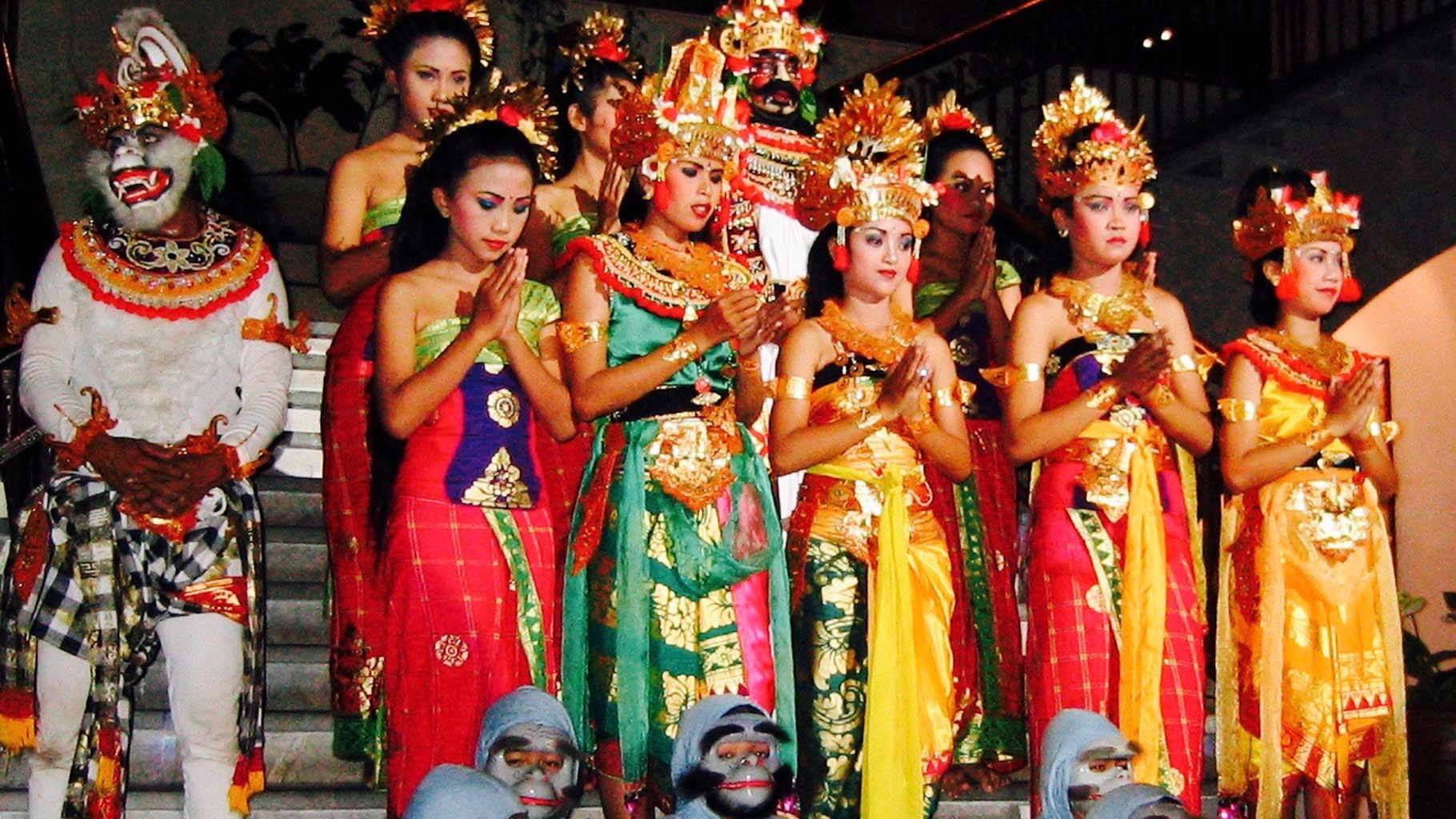Ramayana in Indonesia
It is historically believed that the two Great Indian Epics were carried to Indonesia by various traders, warriors, craftsmen, priests, and poets. Various Indonesian and Javanese inscriptions (Sanskrit) dating from 8th to 10th century CE frequently mention the terms Raghav, Bharat, Lanka, Ravan, Sita, Ram, Vali, Ramayan, and Lakshman.

While the earliest known written copy of Ramkatha in Indonesia known as the Ramayan Kakawain was written by Yogiswar (10th century), later various other versions were written too. It is believed by many experts that East Java by itself claims to hold 1200 versions of Ramayana.

The first portrayal of the Ramayan on stone was seen in Central Java, where the epic was carved onto the courtyard balustrades in the Chandi Shiva and Chandi Brahma temples, locally known as Lara Jonggrang. Lara Jonggrang, also has the glory of holding a full pictorial representation of the Ramayan (Balakanda to Uttarakanda). Interestingly, the town closest to this temple is known as Yogyakarta, which in old Javanese means Ayodhya (Ram’s birthplace).
Indonesia and Hinduism
Hinduism was the first religion to arrive in Indonesia, followed by Mahayana Buddhism. Prior to the coming of these two religions Indonesians practiced animism. Without competing with each other, Hinduism and Buddhism merged and blended with the native animism, and a peculiar Shiva-Buddha sect was started.

In many parts of Indonesia, the banyan tree is still held as holy; and during harvest, Sri (devi Lakshmi) is held in great reverence in order to avoid offending her. Islam, which was brought to Indonesia by Indian traders from Kerala and Gujarat in the 16th century, slowly took control over the next three hundred years.
However, Indonesian Islam remained separated from the orthodox Middle-east, and amalgamated with Buddhism and Hinduism, changing the religious landscape but touching nothing else for many centuries. While now 95 per cent of the Indonesians follow Islam, majority of them still believe in syncretism. Thus, a common citizen of Indonesia accepts his current duties as a Muslim, while accepting and respecting the religion of his forefathers.
Early Ramayana in Indonesia
In Indonesia (especially Java), the Ramayana (and also Mahabharata) form the base for the famous shadow or leather puppet show known as the Wajang Kulit that starts after the harvest season and continues until the rains start.
This Wajang forms an inseparable part of the Indonesian life, reflecting complex social scenes, with the final glory in the act of good winning over evil. Such is the hold of this Wajang Kulit that orthodox Muslims failed to stop it, and seeing their failure declared that Wajang was started by a Muslim saint named Sunan Kalijaga.
While the main themes in Wajang Kulit are from Ramayan and Mahabharat, there have been many changes based on local traditions and norms, thereby further increasing its popularity and helping it grow.
A reading of the various Ramayanas found across the South East Asian countries show the widespread influence Rama’s tale once had across various nations. While narratives vary, and often perspectives seem different owing to religious and cultural differences, these Ram Kathas have become an integral part of people’s lives in these foreign nations.

Despite some attempts to erase the past history, Indonesia has shown how strongly Ramayana has been imbibed into the consciousness of the common people, and that it cannot be forcefully taken away.
South Indian sea traders brought Hinduism with them to Indonesia. Indonesian royalty welcomed Indian religions and culture, and it is they who first adopted these spiritual ideas followed by the masses.
Different Ramayana in Indonesia
It is believed that the Indonesian version of the epic was written during the Medang Kingdom (732-1006 AD) in Central Java. It is known as Kakawin Ramayana, as it is in kakawin meter in Old Javanese language. At the time, Buddhism was dominant in Sumatra, West, and Central Java.
Through shadow puppetry (wayang kulit and wayang purwa), the story of Ramayana helped bring about a resurgence in Hinduism. Of course, the story has been adapted from the original and changed a bit throughout the centuries. The version that you get in Indonesia is different from the one you might see in Thailand, and both are quite different from the original.
Characters of Ramayana
Rama: The story is about his journey, so he’s basically the main character. He is the eldest and favorite son of King Dasharatha. Many Hindus believe he is a reincarnation of the god Vishnu.
Sita: She’s a beautiful princess and daughter of King Janak, who found her in a furrow and regarded her as a blessed child. Through a competition, she becomes Rama’s wife.

Lakshmana: Brother of Rama, he protects Sita and Rama during their time in exile in the forest.
Ravana: The ten-headed King of Lanka, he is a powerful demon who abducts Sita.
Jatayu: A great bird who fights Ravana to fight Sita but is eventually killed.
Hanuman: A leader of the monkey tribes who aligns with Rama in his fight against Ravana. As his father was the God of Wind, he had many supernatural abilities that he uses in battle.
Temple Architecture Brings Ramayana Alive
Prambanan is a 9th-century Hindu temple compound in Special Region of Yogyakarta, Indonesia, dedicated to the Trimūrti, the expression of God as the Creator (Brahma), the Preserver (Vishnu) and the Transformer (Shiva). The temple compound, a UNESCO World Heritage Site, is the largest Hindu temple site in Indonesia and the second-largest in Southeast Asia.
Inside the largest temple of the complex is the story of Ramayana in stone relief. On the main temple at Prambanan, the entire Ramayana is told in stone relief. The Prambanan Ballet is also held at the Prambanan Temple complex.
Popular to Puppet Shows
Wayang, also known as wajang, is a form of puppet theatre art found in Indonesia and other parts of Southeast Asia, wherein a dramatic story is told through shadows thrown by puppets and sometimes combined with human characters.
The art form celebrates Indonesian culture and artistic talent; its origins are traced to the spread of Hinduism in the medieval era and the arrival of leather-based puppet arts called thalubomalata from southern India.

Wayang refers to the entire dramatic show. Sometimes the leather puppet itself is referred to as wayang. Performances of shadow puppet theatre are accompanied by a gamelan orchestra in Java, and by gender wayang in Bali.
The dramatic stories depict mythologies, such as episodes from the Hindu epics the Ramayana and the Mahabharata, as well as local adaptations of cultural legends. Traditionally, a wayang is played out in a ritualized midnight-to-dawn show by a dalang, an artist and spiritual leader; people watch the show from both sides of the screen.
These are Wayang Kulit puppets being used to tell the Ramayana story. The puppet master is speaking in high class Javanese. The show is at the Sultan’s palace in Yogyakarta, Java, Indonesia.
@religionworldin
[video_ads]
[video_ads2]









